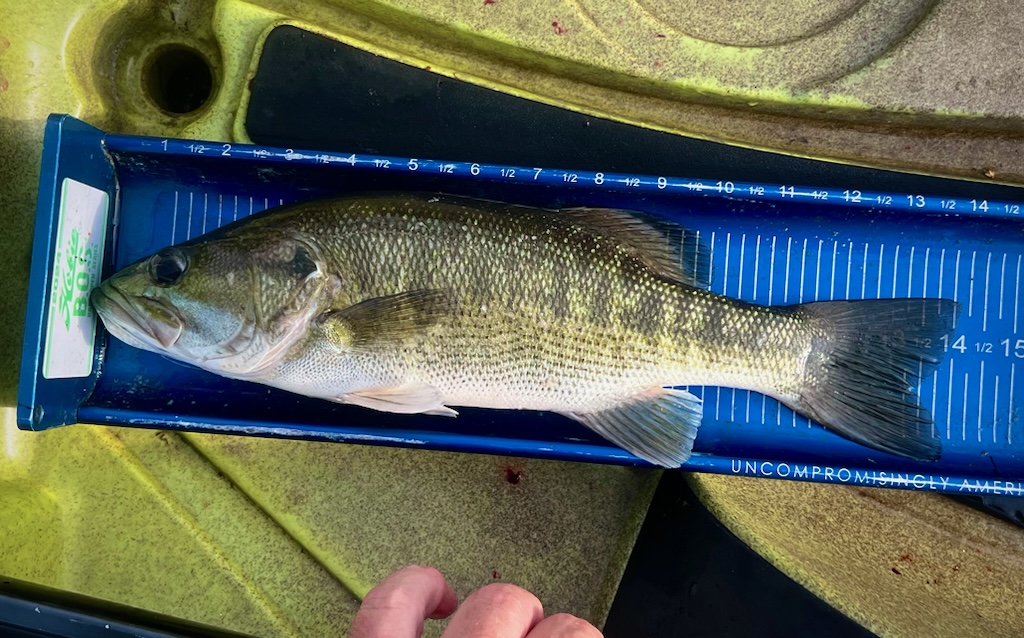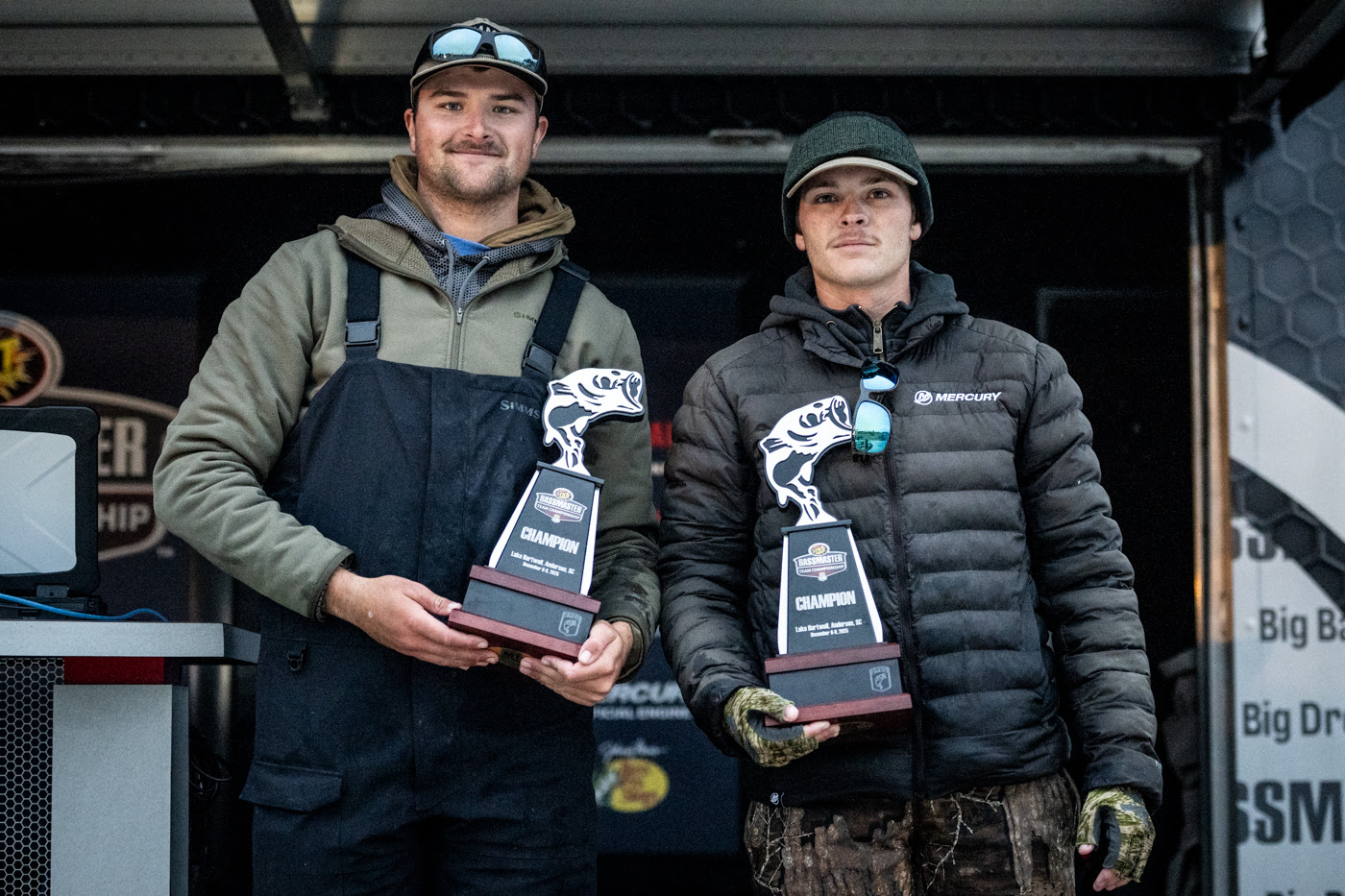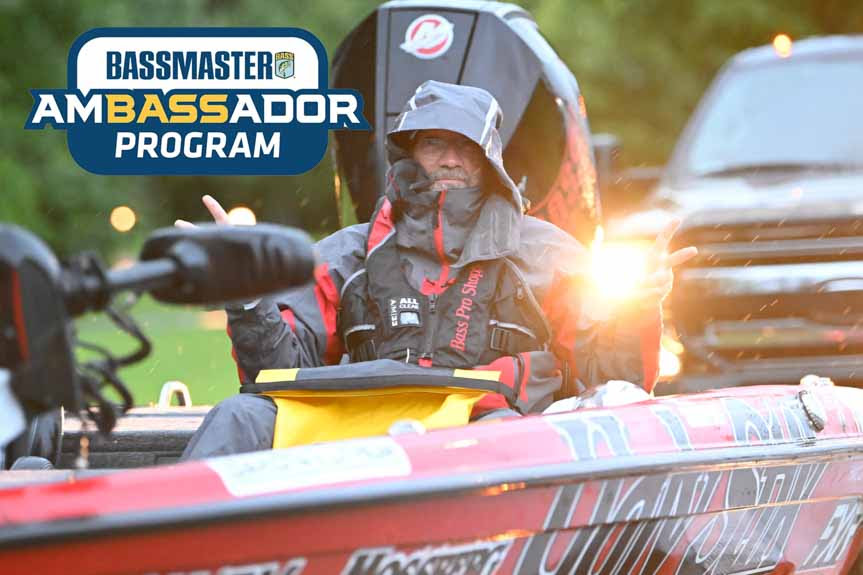After a half-century on this earth, I have a new fishing obsession – the shoal bass
By Vance McCullough – AC Insider
In the opening scene of the classic film Gladiator a Roman soldier declares, “People should know when they’re conquered.”
It’s doubtful that any ancient Romans ever met a shoal bass, but anglers around Rome, Georgia sure have. And, as with the barbarian horde dispatched by Maximus and crew in the movie, the shoalie has a ton of fight in him. This fish just doesn’t know when to quit.
And the fighting isn’t over once you bring the shoalie to hand, especially if you’re in a kayak tournament and have to take a picture of said fish lying still on a measuring board. They’re harder to photograph than a two-year-old. Even more so for the smallest fish. Why would you photograph an 8-inch fish? More on that later but just know that it’s like trying to grasp a wet bar of soap that has muscles.
Even catching a small shoal bass is fun and the type of scenery in which they swim is beautifully rugged, making for a great overall experience.
Credit given where due, I have to thank Drew Gregory for my introduction to – and now addiction to – the shoal bass.

Gregory has won everything an angler can win on the bass tournament side of the kayak fishing world, a scene that has become more electronic, more insulated from the beauty and
mystery that called most of us to fish from kayaks in the first place.
He’s established a new tournament trail for those who pursue bass from paddlecraft, pedalcraft and even motorized ‘yaks from deep offshore ledges in lakes to the shallowest confines of the skinniest feeder creeks. It’s an open-minded approach appropriately named the Kayak Adventure Series.
‘Choose your own adventure’ promises the KAS with tournaments staged on diverse waters across the country and across the calendar. The first event, Shoaliepalooza, was based out of
Thomaston and put half of Middle Georgia in play. While largemouth and spotted bass counted too, the idea was to celebrate a regional favorite, little known outside the state – the
shoal bass.
I decided to participate in the spirit of the event and fish in a way foreign to me for a fish I’d never met rather than seek the familiar largemouth in nearby lakes. A little research revealed that shoal bass will eat anything largemouth will. A swim jig seemed like a good place to start. It was. I soon caught a few modest sized shoalies. I wish I’d turned to topwaters sooner. I now believe they often attract the biggest shoal bass as I know they do largemouth, as well as saltwater species such as snook and many other sportfish.
Some things are just universal.
That said, Aaron Griffith won this event with 102.25 inches of shoal bass and caught every one of them on a black trick worm Texas-rigged on a 1/8oz. bullet weight. By the way, Aaron has a great video on his Instagram page, Aarons_outdoor, where he demonstrates how hard it is to simply snap a picture of these rowdy fish.
I finished middle of the pack in Shoaliepalooza but it lit a fire in me. I wanted a rematch with this fish that had teased me, allowed me to catch a couple of 5-fish limits but nothing big.
I felt the strength in these fish that spend a lifetime fighting swift currents. Their scientific name, after all, is Micropterus cataractae – ‘fish of the waterfall’. They were placed by God’s hand along the Fall Line in Georgia – an area of geologic change where the piedmont region gives way to the coastal plains. Abruptly. This rapid loss of elevation causes rapid water movement which has scrubbed numerous ledges of soft substrate and left rocky cataracts and swirling white water where the shoal bass is uniquely fit to thrive.
An outfall of Gregory’s free-thinking mindset that spawned the Kayak Adventure Series to start with was the introduction of the Microbag Challenge, an optional side pot that counts an angler’s 5 smallest fish. This, literally, little contest sponsored by Z-Man features a minimum length of 5 inches. Maximum scoreable size is just below the minimum length for the overall tournament. The slam dunk would be a 25-inch total. Now, imagine trying to hold a small shoalie in place while taking the required picture to document the catch. They slipped through my fingers, all five fingers, numerous times while trying to do so. I had four fish in my Microbag. I lost what would have been my limit fish four other times. They’re harder to get a hook into at that size and once hooked they jump more than bigger fish do. I later learned that I, along with every other contestant but one, was disqualified from the Microbag competition because we were expected to photograph these spastic fish with, at most, a single finger to hold them in place, preferably no touching. It’s a special rule put in place so that we don’t obscure too much of the diminutive trophy from view of the judges, but c’mon Drew – REALLY?
I love Drew Gregory, but we might have to arm wrestle over changing that rule in the future. Maybe we can duct tape the little firecrackers to the board or something.

At any size, shoal bass are strong. River bassin’ is a breath of fresh air from the claustrophobic confines of overbuilt, overstuffed modern fishing kayaks. Less is more when it comes to gear. Travel light. Move fast. Wade fishing is the norm, as it’s often the only practical way to target the best stretches of shoal bass habitat. Just a man pitting his wits and skills against a river and the hidden bounty that swims in it. This is how it has always been; always should be, in my humble opinion.
It’s easy to imagine a Cherokee spear fishing from the same boulder I now stand on, water bulging against it momentarily before rolling around and flowing ceaseless to the sea in a cycle that continues to this day, forming a bridge over the never-ending flow of time, connecting us not just to a place, but to those who once enjoyed it as we do now. During your time on the water, you can score best with a simplified approach.
Crawfish are a staple in the diet of river fish; therefore, jigs work well. Texas-rigged soft plastic craws do too. People commonly throw noisy topwaters and crankbaits, even jerkbaits where depths allow. The aggressive shoal bass is not extremely picky so choose freely from your tackle box. Casting accuracy can be helpful as shoal bass tend to tuck into tight spots that provide tiny current breaks. If your cast lands off the mark they will often come get it anyway, as long as they can see it. You can always toss a lure upstream and let it ride the
current, tumble over the rocks and swirl in the eddy below like a wounded critter would naturally do.
As for their primary range, shoal bass can be found throughout the Flint River from its source, a culvert at the airport in Atlanta, down to Lake Seminole on the Florida border. The Chattahoochee has a few in the mid-to-upper sections. Numerous dams along that river have kept the shoal bass populations from expanding much. The world record, at 8lbs, 12oz, came from Florida’s Apalachicola River years ago, but the populations there and in the nearby Chipola River have fallen off in recent years. It is estimated that 90% of the shoal bass now reside in Georgia.
They prefer main river, current-swept habitat and are seldom found in smaller creeks. They were introduced into the Ocmulgee in 1975 and have established themselves well from below the Lloyd Shoals Dam that impounds Lake Jackson all the way down to the river’s confluence with the Oconee where the two merge to form the Altamaha that carries the waters to the Atlantic Ocean.
The most consistent shoal bass action is centered around Georgia’s Fall Line which runs roughly from Columbus, through Macon and on to Augusta. One of the hardest things for me to get my head around was that shoal bass actually spawn in the fastest, most turbulent water they can find. Most sunfish nest in calm, undisturbed areas and then feed in heavy current. But M. cataractae plays out its whole life in the roiled rivulets among the topographic feature for which it is named. That’s commitment.
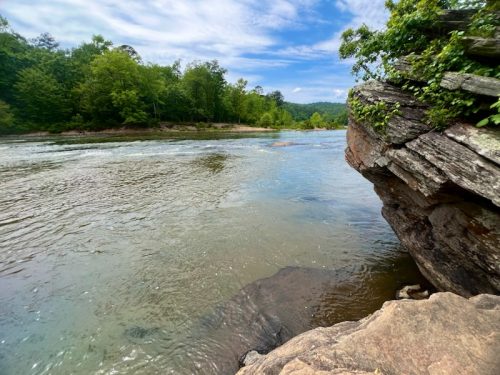
It rivals the commitment shown by those who chase this bass, who take pride in sharing a region with it, some of whom seem to identify with it on a deep level. Few animals engender such pride in such a tightly defined region as the shoal bass does.
I understand it now.
While Shoaliepalooza was fun but not profitable for me, it served as my introduction to the species and the magnificent environment it dragged me into. I might have caught 15 fish,
including a handful of Alabama spotted bass. My biggest shoal bass was 14 inches. Not bad, but I knew there was more to this fish than I had encountered.
Fast forward two weeks. My wife and I were celebrating 30 years of marriage. If I did one thing right in my entire life, I married well. Christy loves camping. And she’s an enabler of my fishing habit. She will catch a few now and then herself, but on this trip she slept in each morning and let me attack the little rapids visible from the balcony of our small cabin along Georgia’s Ocmulgee River.
The first morning I used a plastic craw and only caught a couple of small fish. The next morning, I tossed a topwater crawler, specially painted in a redwing blackbird pattern by my good friend Daniel Winkles of DW Lures, and before I even waded into the cool clear flow a shoalie erupted with prejudice on my hapless plug as it careened over the lip of a tiny waterfall. The scene was spectacular. She dug like a redfish and swam in wide circles, flashing those gorgeous tiger stripes and golden back as I made multiple attempts to grab her. She pulled my digital scale to 3.08 pounds and measured from the tip of my middle finger to the crook of my elbow. She was the first of three nice shoalies to greet me that final morning of the trip.

I totally get it now, this fascination with the strikingly beautiful fish and her naughty attitude. And I can’t wait to go back. Best news is, the peak season for river fishing is just around the
corner. This is a summertime fishery that will delight vacationing families and anglers who want to steal a couple hours from the schedule while others sleep in.
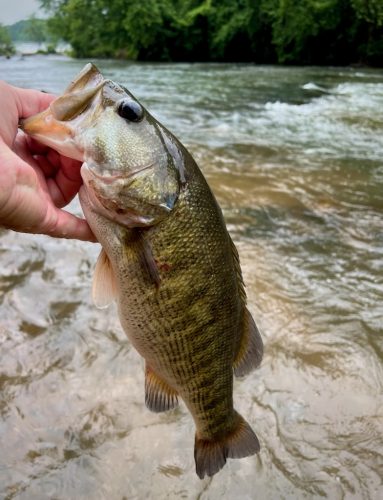
So far this year the rivers of Middle Georgia have maintained a good level for accessing and wade-fishing them. The water has been beautiful with just a light stain and excellent visibility down to at least three or four feet in the areas of the Flint and Ocmulgee rivers that I have fished. In other words, I could see the bottom practically everywhere. As for lures, anything that works on largemouth will catch a shoalie, but I prefer topwater lures for obvious reasons, including the fact that they will swim above the rocky snags where shoal bass tend to hang out.
A basic rule of wade fishing in rivers is to work your way upstream so the water carries away the silt you stir, and you won’t muddy up the stretch you’re trying to fish. This also helps you to better see the sometimes slippery, rock-strewn bottom where you may need all the help you can get to find solid footing to start with.
Of course, safety is of great importance. Wear a life jacket and if possible, have a friend tag along. At the very least, file a float plan with somebody or let them know where you plan to be. Those cascading stretches of river can be dangerous. But they are beautiful and so is the unique fishery they hide beneath their swirling, falling waters.
Planning your shoal bass adventure: if you plan to fish the Flint River, you’d be hard pressed to find a better place to stay than at Sprewell Bluff State Park, 10 miles west of Thomaston, about an hour south of Atlanta.
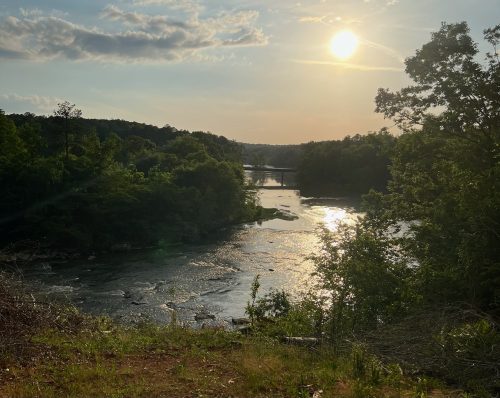
You can rent a small, air-conditioned cabin for $95/night or bring your tent or RV for $45. You’ll share a bathhouse with other campers, even if in a cabin, but that’s the only drawback in this idyllic setting. Perched atop a high ridge, the park straddles 568 acres of wilderness and offers hiking trails, swimming, paddling, and of course, fishing. There’s a trading post and gift shop open from 9 AM-to-5 PM daily. A gorgeous overlook greets you as you enter the park and the wild, beautiful Flint River rolls around the base of the bluff.
Book your stay at ReserveAmerica.com.
Nearby Thomaston, GA has everything you could need, including some cool restaurants and bars and even a classic old theater – the Ritz. A little closer by is the River Bend restaurant with a sweeping view of the Flint and a classic southern menu. There’s also a Dollar General, a gas station and the Sunnyside Café about 10 minutes away in Sunset Village (as it’s called on the map, although the locals call the little dot on Hwy 74 “Sunnyside”).
Flint River Outdoors Center, 4429 Woodland Rd, Thomaston, GA, 706-647-2633, is a great source of information about the river, its current level, etc. They also offer tent camping, and a few RV sites.
The coolest thing about Flint River Outdoors Center is their shuttle service that runs between, among other places, Sprewell Bluff and their own ramp. You can rent one of their kayaks or
bring your own and have them shuttle you back upriver when you’re done floating and fishing.
As for the Ocmulgee, the tiny town of Juliette, GA, population 290, is a great place to base camp. My wife and I stayed at Towaliga River Retreat in a small cabin (complete with a private bath, thank you very much) for about $125/night. Plan to grill or eat out as the kitchenette only has a small microwave and minifridge. There’s a charcoal grill and fire ring at each cabin. Dining is plentiful in Forsythe, 10 miles west, or in Macon, about 20 miles south. There are also tent and RV spaces available at this well shaded stretch of riverbank that has a 1.6-mile hiking trail and is very near many other world-class hiking and mountain biking trails.
There is plenty to do besides fishing. The one-street town of Juliette is actually a ghost town, rebuilt for the filming of the movie Fried Green Tomatoes in the early 1990’s. The buildings are still set up and open for visitors, many of whom come to dine at the Whistle Stop Café which, I can attest, serves some of the finest southern cuisine you’ll ever eat including, of course, fried green tomatoes. Be advised, the café and other attractions along the street are open from 11 AM-to-4 PM only, and most of them only from Thursday through Sunday.
There’s a low head dam, the Juliette Dam, built to divert water to the still-standing Juliette Mill, a 4-story building that, when built in 1927 was the world’s largest stone wheel grist mill, turning a million bushels of corn per year into the popular Juliette brand grits. It later housed a motorcycle museum. It’s now vacant but posted, but it makes a cool backdrop for fishing photos.
Above the dam is a waterfront park and boat ramp where you can access miles of slack water on the Ocmulgee and get a good look at the old mill.
WARNING: low head dams are dangerous, please stay well clear when below or above one. They can suck you into a ‘washing machine’ effect so strong that your life jacket won’t be able to keep you afloat. Kayak angling expert Jeff Little has an excellent video about this on his Youtube channel – The Little Stuff – if you’d like to research further.
For current information about the Ocmulgee River near Juliette, call or stop by Juliette Bait and Tackle at 12392 State Road 87 in Juliette, GA, phone number 478-262-1015. They can even hook you up with a guided rafting trip for trophy shoal bass.
